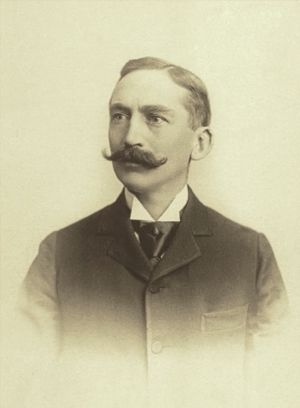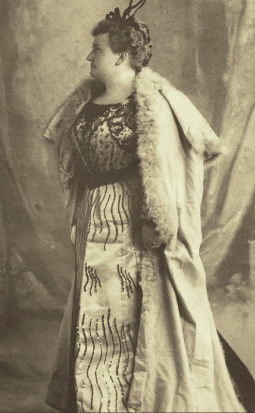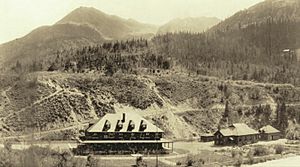Edward G. Stoiber facts for kids
Quick facts for kids
Edward G. Stoiber
|
|
|---|---|
 |
|
| Born | September 18, 1855 New York, New York
|
| Died | April 21, 1906 (aged 50) Paris, France
|
| Burial place | Fairmount Cemetery, Denver, Colorado |
| Nationality | American |
| Education | School of Mines, Freiberg, Germany |
| Occupation | Mining engineer and businessman |
| Spouse(s) | Lena Stoiber |
Edward G. Stoiber (September 18, 1855 – April 21, 1906) was an American mining engineer and businessman. He owned the Silver Lake Mines and Mills near Silverton, Colorado. Edward studied mining in Germany. When he returned, he worked as a mining engineer in Leadville, Colorado.
In the mid-1880s, Edward started a business with his brother Gustavus. They built a mill and mine in San Juan County near Silverton. By 1887, the brothers decided to work separately. Edward kept the Silver Lake mine. The next year, he married Lena Allen Webster. She became a joint owner of the business and helped manage it.
Edward focused on finding smart ways to mine and process low-grade ore. This was important to make mining profitable. He studied different mining methods until his company became very successful. This success also helped the entire San Juan mining area. Lena was a strong manager who made sure the mining operations ran well. She even wore men's clothes and did hands-on work when needed. Edward and Lena were also involved in community projects and helped others. They were both members of the American Institute of Mining Engineers.
Contents
Early Life and Education
Edward G. Stoiber was born on September 18, 1855, in New York City. His parents were Helena Rouse and Felix Stoiber. They were part of the German Evangelical Mission Church in New York City. Edward went to the School of Mines in Freiberg, Germany. He earned a degree in mining.
Mining Career
New Mining Methods
Because of the rugged terrain, little headway could be made in tapping the rich gold and silver deposits as long as the veins could only be reached by mule train over dangerous mountain trials, Things changed dramatically in the 1890s. As Duane Smith notes, this decade marked the coming of the end of an era dominated by graduates of the school of hard knocks. College-trained men moved to the forefront, to the dismay of many old-timers. They knew geology, mining engineering, and smelting. One of this new breed [was] Edward G. Stoiber.
When people first looked for gold and silver in Colorado, they often found lots of metal in the rock. But after a while, the easy-to-find, metal-rich mines ran out. What was left was lower-grade ore. This meant there was more rock than metal. It also made the process of getting the metal out much more expensive. After many years of mining, new, cheaper ways were needed to mine and process this lower-grade ore. This was important to keep making a profit.
Starting in Mining
Edward began his career as a mining engineer. He joined the American Institute of Mining Engineers in 1877. He worked in Leadville for three years.
In the mid-1880s, Edward and his brother Gustavus bought about 200 mining claims. These claims were at the top of Arrastra Gulch. They started the Silver Lake Mine and also ran a place to test ore samples. Edward became very interested in a rich vein of ore near Silver Lake. He began buying more claims there. He built a mine at the lake, which was very high up at 12,250 feet. He started building one of the most modern mining facilities in the West. This included a mill complex at Silver Lake. It was the first mill of its kind at such a high altitude.
In 1887, the brothers had a disagreement and ended their business together. Edward kept the Silver Lake mine. He studied new ways and tools to process ores. He became one of the first miners to make money from processing low-grade mixed ores.
Working with Lena
Edward married Lena Allen Webster in Chicago on March 29, 1888. Lena became very involved in the business. She worked in the mine and helped install machinery. She even wore men's clothing while she worked. Edward and Lena were joint owners of the business. Edward handled the engineering side, while Lena managed the miners. She was known as "Captain Jack" because of her strong personality. Lena also became a member of the American Institute of Mining Engineers in 1894.
Business Success
In 1895, Edward had a long tramway built. This tramway was 8,640 feet long and was used to move ore down the mountain to Arrastra Gulch. It could move five tons of material every hour. The processed ore was then sent to a branch of the Silverton Railroad.
Edward kept making his mining business bigger. He partnered with J.H. Robin. He added another mill and a faster tramway. This new tramway could move 30 tons of material per hour. His business success brought a lot of wealth to the San Juan mining area.
Waldheim Mansion
In 1897, Edward and Lena built a large house in Silverton called Waldheim. This name means "forest home." The mansion was used as their home and office. It had a special room for plants, a theater, and a ballroom. They also built a power plant that used water to create electricity. This plant powered their mine, mill, and mansion. In 1901, Edward sold the Silver Lake Mines to the American Smelting and Refining Company. He sold it for $2.35 million.
Personal Life and Community
Edward was well-liked by his employees. He treated them with kindness. He also worked to improve the mining industry across Colorado. He gave large gifts to schools. For example, he donated a set of instruments to the Colorado School of Mines. He also created a science section at the University Club library.
Lena often hosted dances and parties for the workers. She gave presents to children at Christmas. She was a strong partner to her husband. She did whatever was needed to make the business run well. She also treated the workers kindly. Lena helped make Mesa Verde a national park. She also started a women's group that focused on practical and historical studies.
Later Years and Death
After selling his business, the Stoibers lived in Denver. They also traveled a lot in Europe and Asia. In 1904, they moved to Paris, France. They planned to return to Denver to build a new mansion based on Edward's ideas.
Edward became sick with typhoid fever on April 3, 1906. He died in Paris on April 21, 1906. Lena had a large tomb built for him at Fairmount Cemetery. It was made of granite and cost about $30,000. The inside was made of beautiful marble.
After Edward died, Lena worked with architects. She used his sketches to build the Stoiber Mansion in Denver in 1907. Lena died on March 27, 1935, in Italy.
Images for kids






